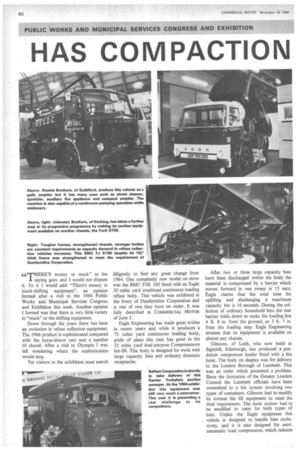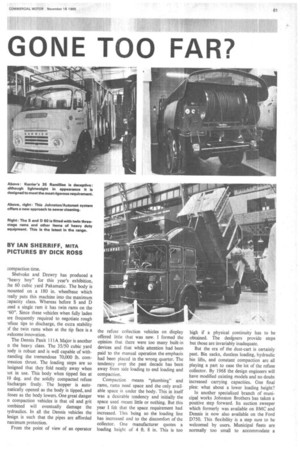HAS COMPACTION GONE TOO FAR?
Page 62

Page 63

Page 64

If you've noticed an error in this article please click here to report it so we can fix it.
BY IAN SHERRIFF, MITA PICTURES BY DICK ROSS Fr HERE'S money in muck" so the saying goes and I would not dispute it. To it I would add: "There's money in muck-shifting equipment", an opinion formed after a visit to the 1966 Public Works and Municipal Services Congress and Exhibition this week. Another opinion I formed was that there is very little variety in "muck" or the shifting equipment.
Down through the years there has been an evolution in refuse collection equipment. The 1966 product is sophisticated compared with the horse-drawn cart and a number 10 shovel. After a visit to Olympia I was left wondering where the sophistication would stop.
Yet visitors to the exhibition must search
diligently to find any great change from 1964. One completely new model on show was the BMC FJK 160 fitted with an Eagle 50 cubic yard crushload continuous loading refuse body. This vehicle was exhibited in the livery of Dunfermline Corporation and is one of two they have on order. It was fully described in COMMERCIAL MOTOR of June 3.
Eagle Engineering has made great strides in recent years and while it produces a 75 cubic yard continuous loading body, pride of place this year has gone to the 35 cubic yard dual-purpose Compressmore bin-lift. This body is designed for work with large capacity bins and ordinary domestic receptacles. After two or three large capacity bins have been discharged within the body the material is compressed by a barrier which moves forward in one sweep in 15 secs. Eagle claims that the total time for uplifting and discharging a maximum capacity bin is 16 seconds. During the collection of ordinary household bins the rear barrier folds down to make the loading line 4 ft. 8 in. from the ground, or 3 ft. 7 in. from the loading step. Eagle Engineering stresses that its equipment is available on almost any chassis.
Gibsons, of Leith, who now build at Sighthill, Edinburgh, has produced a pendulum compressor loader fitted with a bin hoist. The body on display was for delivery to the London Borough of Lambeth. This was an order which presented a problem. Since the formation of the Greater London Council the Lambeth officials have been committed to a bin system involving two types of containers. Gibsons had to modify its normal bin lift equipment to meet the dual requirement. The hoist system had to be modified to cater for both types of bins. Unlike the Eagle equipment this vehicle is designed to handle bins exclusively, and it is also designed for semiautomatic load compression, which reduces compaction time.
Shelvoke and Drewry has produced a "heavy boy" for this year's exhibition, the 60 cubic yard Pakamatic. The body is mounted on a 180 in. wheelbase which really puts this machine into the maximum -:.apacity class. Whereas before S and D used a single ram it has twin rams on the '60". Since these vehicles when fully laden Ire frequently required to negotiate rough refuse tips to discharge, the extra stability af the twin rams when at the tip face is a welcome innovation.
The Dennis Paxit 11 1A Major is another n the heavy class. The 35/50 cubic yard )ody is robust and is well capable of with;landing the tremendous 70,000 lb. corn)ression thrust. The loading steps are so lesigned that they fold neatly away when lot in use. This body when tipped lies at 19 deg. and the solidly compacted refuse iischarges freely. The hopper is autonatically opened as the body is tipped, and loses as the body lowers. One great danger n compaction vehicles is that oil and grit ombined will eventually damage the iydraulics. In all the Dennis vehicles the lesign is such that the pipes are afforded naximum protection.
From the point of view of an operator the refuse collection vehicles on display offered little that was new. I formed the opinion that there were too many built-in devices and that while attention had been paid to the manual operation the emphasis had been placed in the wrong quarter. The tendency over the past decade has been away from side loading to end loading and compaction.
Compaction means "plumbing" and rams, rams need space and the only available space is under the body. This in itself was a desirable tendency and initially the space used meant little or nothing. But this year I felt that the space requirement had increased. This being so the loading line has increased and to the discomfort of the collector. One manufacturer quotes a loading height of 4 ft. 8 in. This is too
high if a physical continuity has to be obtained. The designers provide steps but those are invariably inadequate.
But the era of the dust-cart is certainly past. Bin sacks, dustless loading, hydraulic bin lifts, and constant compaction are all playing a part to ease the lot of the refuse collector. By 1968 the design engineers will have modified existing models and no doubt increased carrying capacities. One final plea: what about a lower loading height?
In another specialized branch of municipal works Johnston Brothers has taken a positive step forward. Its suction sweeper which formerly was available on BMC and Dennis is now also available on the Ford D750. This flexibility is a step sure to be welcomed by users. Municipal fleets are normally too small to accommodate a multiplicity of makes and where standardization can be effected it should be. For those who consider this to be unimportant or who have standardized on Bedford the Bedford/ Lacre suction sweeper is again produced in two models. The most recent machine with the independent power unit was available in 1964. Also in the field for the first time in 1964, but only just, was the Karrier/Yorkshire and during the intervening months this vehicle has proved itself a real challenger to the established makes.
Johnston is also to the fore this year with its Automat. This equipment is used in sewer cleaning and is mounted on a standard chassis. At the moment it is available on the Austin FJK 140 151 in. wheelbase, the Ford D 750 156 in. wheelbase and the Dennis 11A 151 in. wheelbase. The pump is powered by a Ford 40 h.p. diesel engine and runs on gas oil. Johnston had teething troubles with this equipment but this was caused through the pump being too weak. The new pump is capable of delivering 50 gal. a minute and it is claimed that the equipment will clear any diameter of sewer.
If there is money in muck then there is equally as much in scrap, and designed to carry vast quantities of scrap metal is the Dempster Dinosaur. At the exhibition a 20 cubic yard container was mounted on a Dodge KT 900 ready for service with Glasgow Corporation.
One criticism I have of the entire exhibition is that there is too much on show. The field of the Public Works and Municipal engineer is wide but surely the time has come to take stock. This does not mean that one should cut down on the exhibits but that there should be some uniformity. Vehicles were scattered throughout the area; might it not be better to bring sections together? This way it would be easier to make -comparisons and the whole effect would be less bewildering.




































































































































